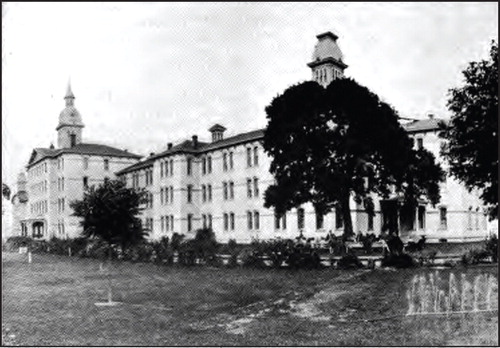Oregon State Hospital, 1883–2008
The controversial Oregon State Hospital in Salem, Ore., was added to the National Register of Historic Places on March 6, 2008. It was created as an asylum based on the principles of “moral treatment” promoted by Dr. Thomas Story Kirkbride (1) and others. Most of the buildings are now unoccupied and decaying. The state is preparing to replace the psychiatric hospital with a new $250 million complex, but the new hospital will not be ready until 2011. The front section of the main building, including the cupola (pictured), will be preserved as a museum on the history of mental health care.

Oregon State Hospital was immortalized as the filming location of the 1975 Academy Award-winning movie One Flew Over the Cuckoo’s Nest . Dr. Dean Brooks, hospital superintendent at the time, agreed to let producers Michael Douglas and Saul Zaentz make the movie at the hospital because space was ample—a vacant ward was used as the main set—and making the movie was calculated to result in “financial and emotional benefits” (2) . Both Douglas and Zaentz promised Dr. Brooks that they would secure the safety, privacy, and integrity of the patients they were disrupting (3) . Indeed, 89 patients were hired as extras, and Dr. Brooks was cast as Dr. John Spivey, playing his real-life role of superintendent!
Two additional factors were considered important by Dr. Brooks in allowing the movie to be filmed at Oregon State Hospital. One was Ken Kesey, author of the book on which the movie was based. Kesey was born in Oregon and worked at a Veterans Administration hospital in California, where he drew on his experiences for the book. The fact that Kesey was an Oregonian was significant to Dr. Brooks. Second, as technical advisor to the movie, Dr. Brooks was keen to help portray the dehumanizing effect of institutions, which he tried to counter in practice by transforming Oregon State Hospital from having primarily a custodial focus to being a therapeutic and learning community (4) .
Sadly, in later years, downsized Oregon State Hospital came under scrutiny for substandard care, including well-documented cases of infectious disease outbreaks and patient abuse and assaults. A grim discovery was made by a group of state legislators touring the facility in 2004. The cremated remains of more than 3,000 patients who died at the hospital from the late 1880s to the mid-1970s were found in corroding copper canisters in a storage room, the so-called “room of lost souls.” They were the remnants of a time when mental illness was so stigmatizing that families abandoned patients.
The new Oregon State Hospital promises to be more than a bricks-and-mortar makeover. State leaders are taking steps to improve care through new treatment programs, better living conditions, and increased security and staffing levels.
1. Kirkbride TS: On the Construction, Organization, and General Arrangements for Hospitals for the Insane With Some Remarks on Insanity and Its Treatment, 2nd ed. Philadelphia, JB Lippincott, 1880Google Scholar
2. Armstrong B: Dean Brooks, superintendent and actor, talks about Cuckoo’s Nest. Hosp Community Psychiatry 1977; 28:46–48Google Scholar
3. Cahill T: Jack Nicholson: knocking round the nest: on the set with Cuckoo’s Jack Nicholson at Oregon State Hospital, where all the ward’s a stage. Rolling Stone, Dec 4, 1975, pp 48–52, 54, 87–88Google Scholar
4. Brooks DK: A bushel of shoes. Hosp Community Psychiatry 1969; 20:371–375Google Scholar



